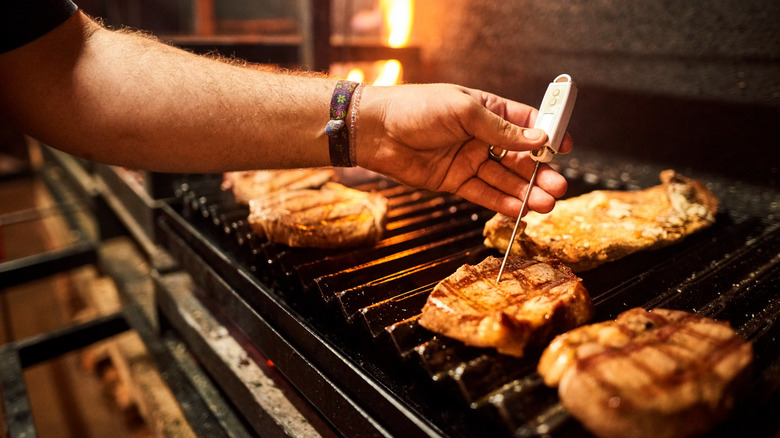No, Probing Your Meat Won't Ruin It
As we're in the midst of the holidays, many of us are cooking various slabs of meat — turkeys, prime ribs, spiral-cut hams, perhaps even a rack of lamb. If they're overcooked or undercooked it could ruin the whole vibe of your celebration — and good luck finding an open pizza place. What you should have done was probe your meat.
Probing, or taking the meat's temperature — contrary to some opinions — won't ruin it, cause all of the juices to run out, or make it dry, whether it's a turkey or a steak. While, yes, some juices will dribble out of the puncture made, it won't ever be enough to make your meat dry. At most your eight-ounce steak is losing a quarter of a teaspoon of liquid from an instant-read thermometer's entry point. This is because anything you poke your meat with — fork, temperature probe, prongs — is too dull to puncture the pockets of meat juice, called fibrils. The bigger concern — the one a probe thermometer helps to mitigate — is overcooking, and thus drying out your meat.
You should be probing your meat with a digital thermometer
Meat needs to reach a minimum internal temperature to be safe for eating; don't leave it up to the poke test or cutting a small X in your meat as those are rather unreliable methods, at least considering the alternative. When you probe your meat with a thermometer, you're ensuring your cut meets that minimum, and not in danger of overcooking.
You can probe your meat several times through the cooking process, and start early, at least a half hour before your timer goes off. It'll give you a good idea of how far along you have to go. Make sure you avoid fat, bone, and any connective tissues. As you insert the probe, you should be able to watch the numbers fall as the probe gets closer to the middle of the meat. If the numbers climb again, you've gone too far, as you're looking for a temperature toward the low end of the safe range. For meats of varying sizes and thicknesses, like a turkey, it's a good idea to check both the thickest part of the breast, as well as the thigh.
And don't forget about carry-over cooking; you should always let your meat rest after cooking, and during that time the internal temperature of your meat will rise. If you pull your meat too late from the heat source, it'll overcook. Pull your cooked meat about five degrees shy of your intended temperature to allow for carry-over cooking.
It's worse to overcook your meat than be afraid of poking holes in your meat
Even a pro will attest that meat subjected to repeated pokes and prods from a probe will end up juicier than a cut allowed to sizzle too long and overcook by a few degrees — moisture lost through evaporation than through the puncture. This is because juices don't run willy-nilly through a piece of meat, as they're bound up in the muscle proteins. As the meat cooks, these proteins shrink and expel meat juices. When we probe a ham or a steak, we're only disturbing the juices in that area, and nothing else. Cooking your meat beyond its optimal internal temperature will squeeze more of these precious juices out. You'll cook meat perfectly every time with your meat thermometer.
If there are still some pinkish juices flowing through the meat and it freaks you out, you should be fine if your temperatures are consistent (with an accurate thermometer) and indicate your meat is cooked. At high temperatures these juices will make a piece of meat look more underdone — this is myoglobin that didn't completely break down during cooking and is what can sometimes give your meat an undercooked appearance, but trust the probe and don't be fooled.


